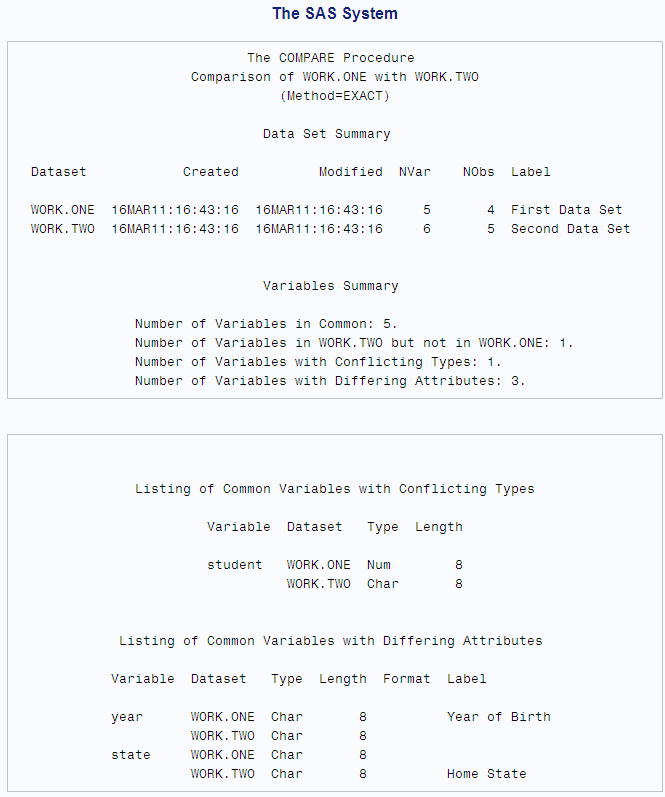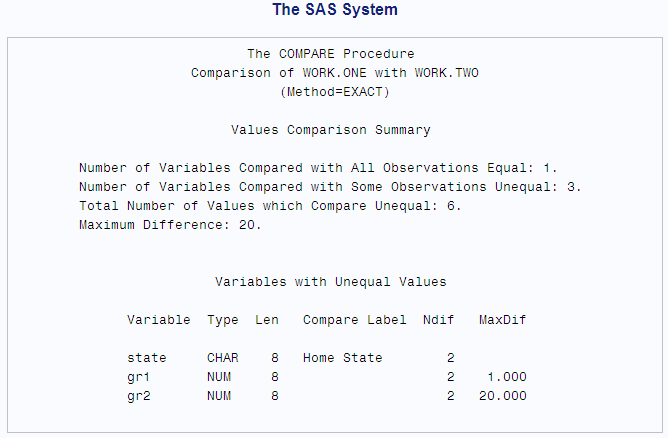COMPARE Procedure
- Syntax

- Overview
- Concepts
- Results
- Examples
 Producing a Complete Report of the DifferencesComparing Variables in Different Data SetsComparing a Variable Multiple TimesComparing Variables That Are in the Same Data SetComparing Observations with an ID VariableComparing Values of Observations Using an Output Data Set (OUT=)Creating an Output Data Set of Statistics (OUTSTATS=)
Producing a Complete Report of the DifferencesComparing Variables in Different Data SetsComparing a Variable Multiple TimesComparing Variables That Are in the Same Data SetComparing Observations with an ID VariableComparing Values of Observations Using an Output Data Set (OUT=)Creating an Output Data Set of Statistics (OUTSTATS=)
Overview: COMPARE Procedure
What Does the COMPARE Procedure Do?
The COMPARE procedure
compares the contents of two SAS data sets, selected variables in
different data sets, or variables within the same data set.
PROC COMPARE compares two data sets: the base data set
and the comparison data set. The procedure determines matching variables
and matching observations. Matching variables are variables with the
same name or variables that you pair by using the VAR and WITH statements.
Matching variables must be of the same type. Matching observations
are observations that have the same values for all ID variables that
you specify or, if you do not use the ID statement, that occur in
the same position in the data sets. If you match observations by
ID variables, then both data sets must be sorted by all ID variables.
What Information Does PROC COMPARE Provide?
Further, PROC COMPARE
creates two kinds of output data sets that give detailed information
about the differences between observations of variables that it is
comparing.
The following example
compares the data sets PROCLIB.ONE and PROCLIB.TWO, which contain
similar data about students:
data proclib.one(label='First Data Set');
input student year $ state $ gr1 gr2;
label year='Year of Birth';
format gr1 4.1;
datalines;
1000 1970 NC 85 87
1042 1971 MD 92 92
1095 1969 PA 78 72
1187 1970 MA 87 94
;
data proclib.two(label='Second Data Set');
input student $ year $ state $ gr1
gr2 major $;
label state='Home State';
format gr1 5.2;
datalines;
1000 1970 NC 84 87 Math
1042 1971 MA 92 92 History
1095 1969 PA 79 73 Physics
1187 1970 MD 87 74 Dance
1204 1971 NC 82 96 French
;How Can PROC COMPARE Output Be Customized?
PROC COMPARE produces lengthy output.
You can use one or more options to determine the kinds of comparisons
to make and the degree of detail in the report. For example, in the
following PROC COMPARE step, the NOVALUES option suppresses the part
of the output that shows the differences in the values of matching
variables:
options nodate pageno=1 linesize=80 pagesize=40;
title 'The SAS System';
proc compare base=proclib.one
compare=proclib.two novalues;
run;
Procedure Output shows the default output for these two
data sets. Producing a Complete Report of the Differences shows the complete output for these two data sets.


